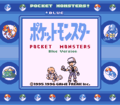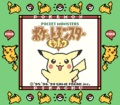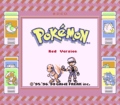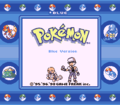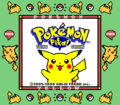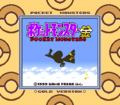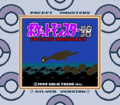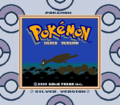Game Boy Tower
A Game Boy Tower (Japanese: GBビル GB Building) is a location in the Pokémon Stadium series where players may play Game Boy Pokémon games using the Transfer Pak. The Tower places a border around the game screen, using the same borders as the Super Game Boy accessory, with the exception of Pokémon Crystal, which uses a generic border designed after a Game Boy; this same border is seen for a few moments in all games while it loads the boot ROM before rendering the Super Game Boy border and then booting the games in either Super Game Boy mode (for the Generation I games other than international Pokémon Yellow) or Game Boy Color mode (for the Generation II games and international Pokémon Yellow).
When the Japanese Pokémon Red, Green, or Blue are played on the Game Boy Tower, the animations of some moves are slowed down significantly, more so than in the edited animations of Japanese Pokémon Yellow and Western Pokémon Red, Blue, and Yellow. This can occasionally cause brief graphical bugs with some moves, such as Body Slam. When played on a Super Game Boy or Game Boy Player, however, the animations are shown in their original unedited form.
Upgrades
The player can unlock upgrades for the Game Boy Tower by completing various cups. The Doduo Game Boy Tower allows games to be played at twice the speed, while the Dodrio Game Boy Tower allows games to be played at three times the speed (four times the speed for Generation I games in Pokémon Stadium 2).
In the Japan-only Pokémon Stadium, the Doduo Game Boy Tower is unlocked by clearing either the Level 1-30 Division tournament or the Level 50-55 Division tournament. Likewise, the Dodrio Game Boy Tower is unlocked by clearing both cups. Similarly, in the Western Pokémon Stadium (known as Pokémon Stadium 2 in Japan), the Doduo Game Boy Tower is unlocked in the original Stadium by completing the Poké Cup or the Prime Cup, while the Dodrio Game Boy Tower is unlocked by completing both cups.
In Pokémon Stadium 2 (known as Pokémon Stadium: Gold & Silver in Japan), the Doduo Game Boy Tower is unlocked for Generation I games by completing the Gym Leader Castle or clearing all of the Stadium Cups in Round 1, and the Dodrio Game Boy Tower is unlocked by completing both. To unlock the modes for the Generation II games, the same requirements must be met in Round 2. In Pokémon Stadium 2, when Doduo mode is used with a Generation II game, the border changes to black and applies a sepia-tone effect to the game display. Stadium 2's Dodrio mode, when used with a Generation II game, changes the game display's tone to black-and-white. Additionally, these modes cannot be used with a Generation II game until the Generation II game clears the Elite Four for the first time.
Gallery
Generation I
Generation II
Trivia
- The Game Boy Tower appears to use a modified version of the Super Game Boy 2's BIOS; if it is forced to run a Game Boy or compatible Game Boy Color game other than the core series Pokémon titles, the Game Boy Tower will run the programming on it identically to the peripheral, complete with Super Game Boy-compatible games utilizing the special borders, colors, and sounds programmed onto their cartridges. However, the Game Boy Tower's save feature will not function in this scenario due to the Pokémon Stadium games not being programmed to recognize these ROMs.[1][2]
- Pokémon Red and Blue cartridges are only supported by their corresponding Pokémon Stadium language. However, because Spanish versions of Pokémon Red and Blue were released in Latin America (with the translation from Spain), it was necessary to make them compatible with the American version of Pokémon Stadium (which was the official released in Latin America). On the contrary, because Pokémon Yellow was released only in English in Latin America, the Spanish version (from Spain) is not compatible with the American version of Pokémon Stadium (since it wasn't necessary to do so).[3]
- The Latin American versions of Red and Blue have a different loading screen and take longer to load because the Stadium games have to recognize the 14 exclusive characters of the Spanish language first, these are: Á, á, É, é, Í, í, Ñ, ñ, Ó, ó, Ú, ú, ü, ¡ and ¿.[4]
- Pokémon Crystal also takes longer to load compared with the other Generation II games, this may be because it is a full Game Boy Color game. The Crystal Version also uses the loading screen of the Latin American versions of Red and Blue.
In other languages
| ||||||||||||||||||
References
| |||||||||||||

|
This article is part of Project Locations, a Bulbapedia project that aims to write comprehensive articles on every location in the Pokémon world. |




